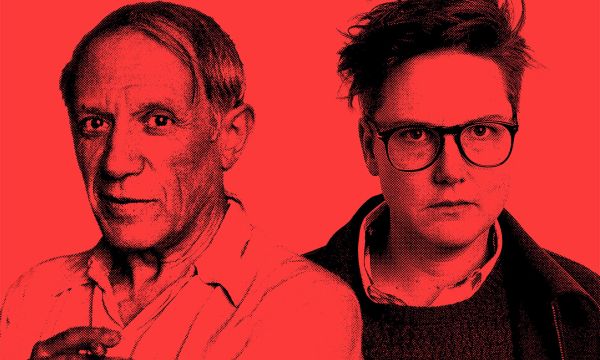Pablo Picasso (1920) © Estate of Pablo Picasso/Artist Rights Society, New York and Hannah Gatsby (2018) Photo: Alan Moyle
Our Picasso show, It’s Pablomatic: Picasso According to Hannah Gadsby, which opens to the public today, was always going to be controversial.
We are one of only 50 museums around the world invited to organise an exhibition marking the 50th anniversary of Pablo Picasso’s death. The aim? To explore what he and his art mean to audiences today. As we discussed how our institution could mark this milestone, one thing was always clear: our show should spark dialogue and expand the canon, two essential elements of our mission.
Since the Brooklyn Museum is the only art museum in the US with a feminist centre, it wasn’t lost on us that Picasso’s death in 1973 coincided with the paradigm-shifting emergence of the second wave of feminism and the entry of women into every corner of the art world.
In the half-century since Picasso’s death, feminist artists, curators and art historians have rewritten the canon. They’ve questioned the dominant masculine narratives of modernism, the designation of “genius,” the impact of personal behaviour, and the significance and current reception of complex historical figures such as Picasso.
That’s why we knew this was the time to explore Picasso’s legacy through a feminist lens and include the voices of some of the most significant women artists to have emerged in the years since Picasso’s death. That’s also why the exhibition dives into Picasso’s approach to women—a subject that is well-documented yet remains provocative. And that’s why we invited the Australian comedian Hannah Gadsby to co-curate the show with our senior curator of feminist art, Catherine Morris, and our senior curator of European art, Lisa Small.
We met Gadsby, who was an avid student of art history in college, shortly after the launch of their award-winning stand-up comedy show Nanette. In that performance, Gadsby holds the art world accountable for its role in suppressing non-majority perspectives. They do not let museums off the hook for frequently condoning and perpetuating art history’s inherent misogyny. Gadsby’s enthusiasm for calling out Picasso’s problematic behaviour and for questioning the cultural climate and cultural institutions that downplay—or even romanticise—such behaviour, made them the obvious choice for helping us create a show to address the complexities and tensions that Picasso elicits.
Gadsby isn’t the first person to critique Picasso. Countless articles, books, films and exhibitions have been produced that, among other things, consider his treatment of women in both art and life (not to mention his treatment of other cultures), But Gadsby gets at this tricky topic in an entirely new way: comedy.
Gadsby’s is not a lightweight comedy. It’s a comedy that leans into tough themes and pushes us to grapple with cultural tensions around societal injustice. It’s a comedy that shows us why exercising our right to free speech is an inherent part of challenging the status quo. It’s a comedy that spotlights the stories of those marginalised for far too long.
To those who question whether Gadsby’s voice belongs in this exhibit, I would simply ask: Whose interests are threatened by including it? Or, who benefits from excluding it?
We are living in contentious times. The Left is being attacked for being “woke”. The Right is reinvigorating its efforts to ban books. One US state is now prohibiting classroom instruction about sexual orientation or gender identity. Others are blocking teachers from talking about our country’s history of racism and the resulting systemic oppression. A school principal has been ousted because an art teacher showed students an image of Michelangelo’s David. Voices across the political spectrum are “cancelling” anyone they disagree with.
It’s Pablomatic is not about cancelling Picasso. Quite the opposite. Cancelling means refusing to engage. Refusing to have the conversation. Refusing complexity. Ours is an exhibition that invites complexity. And I’m confident Picasso can handle a little complexity. In fact, he invited it.
I’m also confident that our audiences can handle complexity, too.
At the Brooklyn Museum, we have made engaging in difficult dialogues and defending free speech cornerstones of our work. (Remember the Sensation exhibition?) Now is not the time for museums to silence speech or restrict difficult narratives. Women have fought long and hard to have the opportunity and power to write their own stories. The Brooklyn Museum believes that the only way forward is to listen to, and make space for, multiple points of view, particularly thoughtful and informed points of view that haven’t been attended to.
As Gadsby says in Nanette, “I believe we could paint a better world if we learned how to see it from all perspectives, as many perspectives as we possibly could. Because diversity is strength. Difference is a teacher. Fear difference, and you learn nothing.”
We have a lot to learn.
• Anne Pasternak is the director of the Brooklyn Museum, New York

